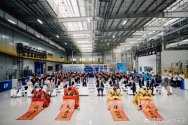One thing people often overlook is that Safran has factories in China that produce the actual engine parts which are then shipped to their 'factory' in France, which is basically an assembly plant, to be put together then shipped back to China or anywhere else in the world, just so their engines can be called "Made in the West".
If they cut off China's engine access, they're basically sanctioning CFM itself and any country with any plane with a CFM engine on it.
I'd love to see someone retarded enough to put forward such a notion and the ensuing fallout not from the Chinese, as they can just sit back and watch the chaos unfold.


If they cut off China's engine access, they're basically sanctioning CFM itself and any country with any plane with a CFM engine on it.
I'd love to see someone retarded enough to put forward such a notion and the ensuing fallout not from the Chinese, as they can just sit back and watch the chaos unfold.


Last edited:

